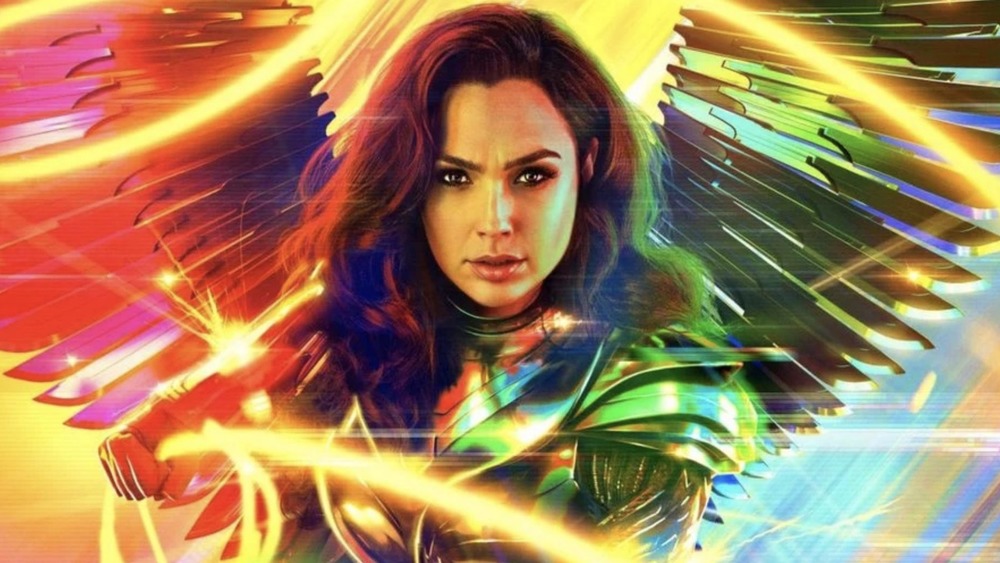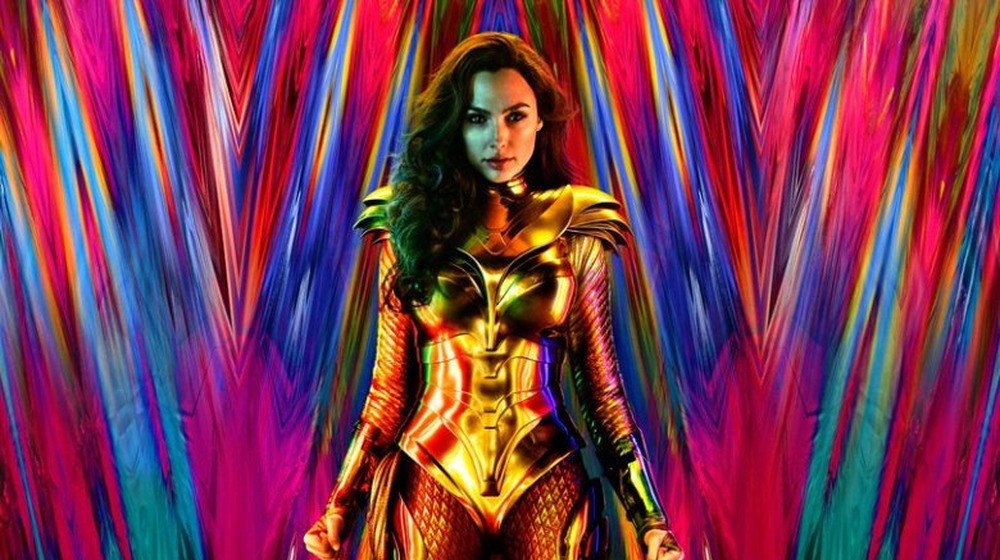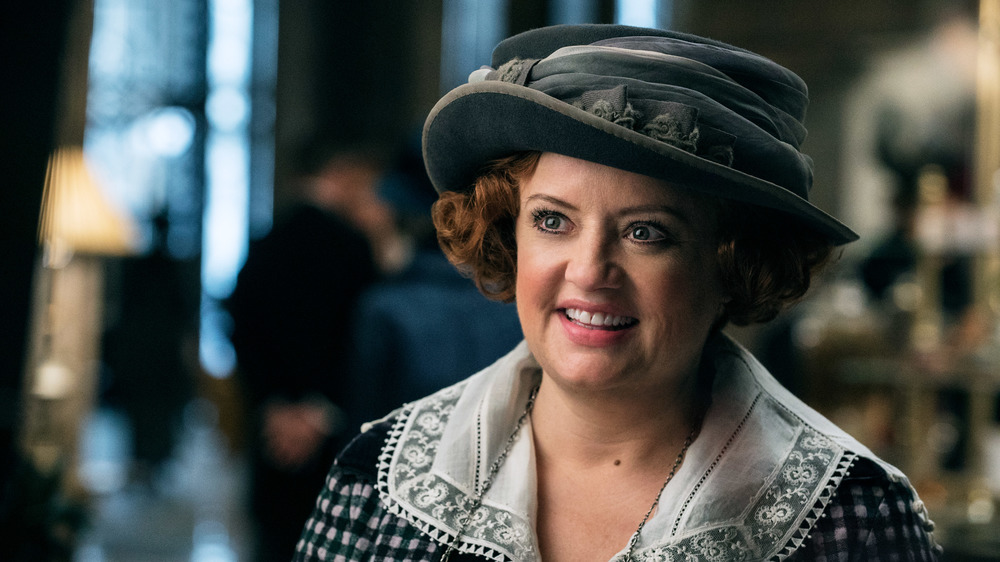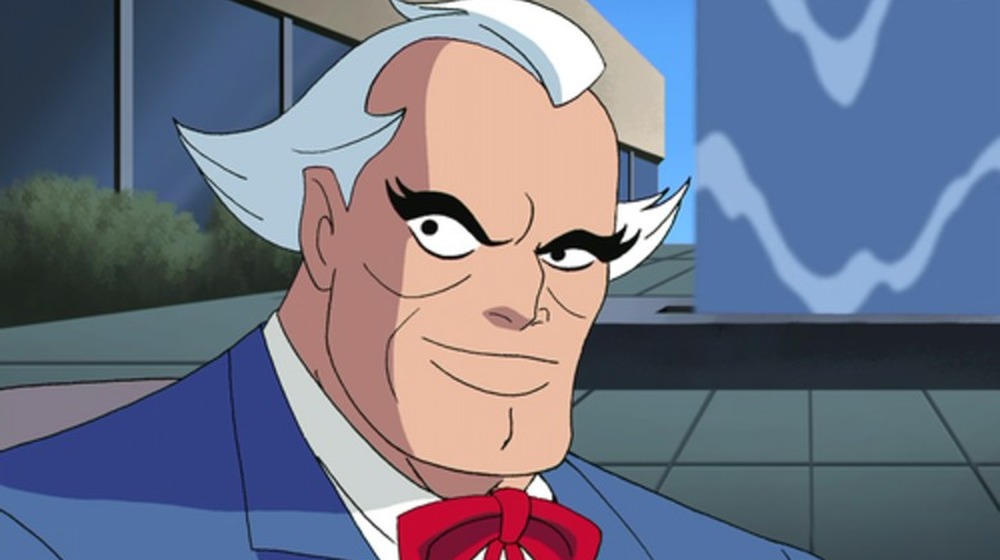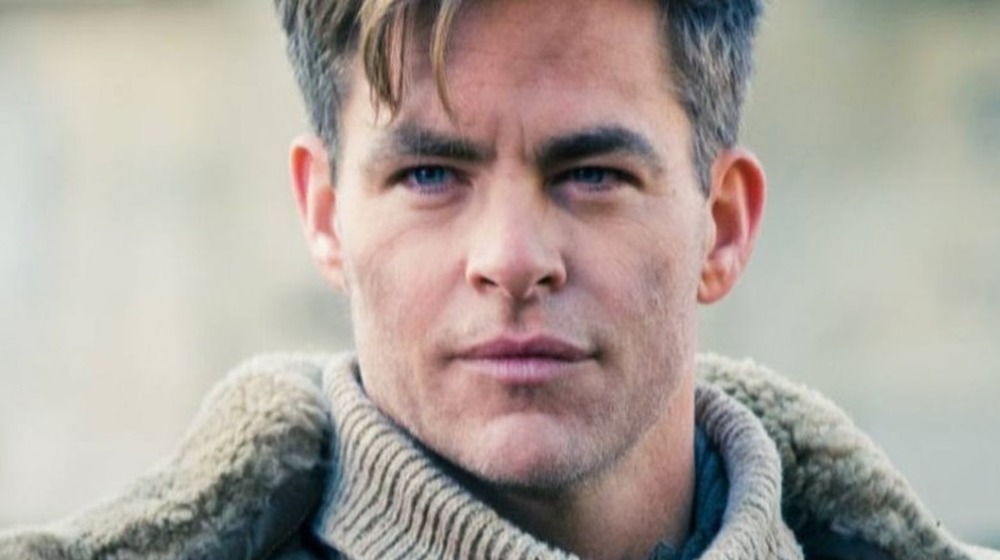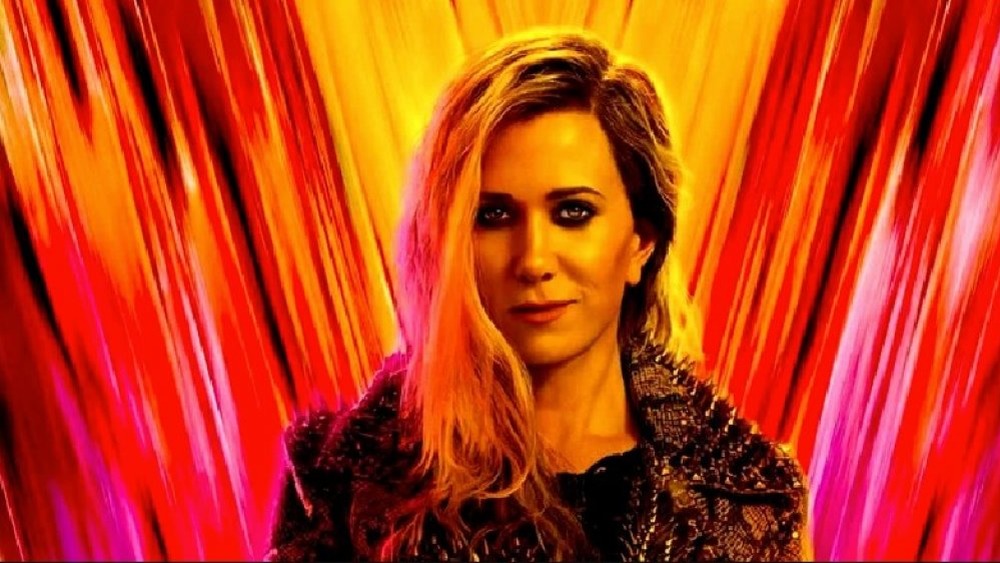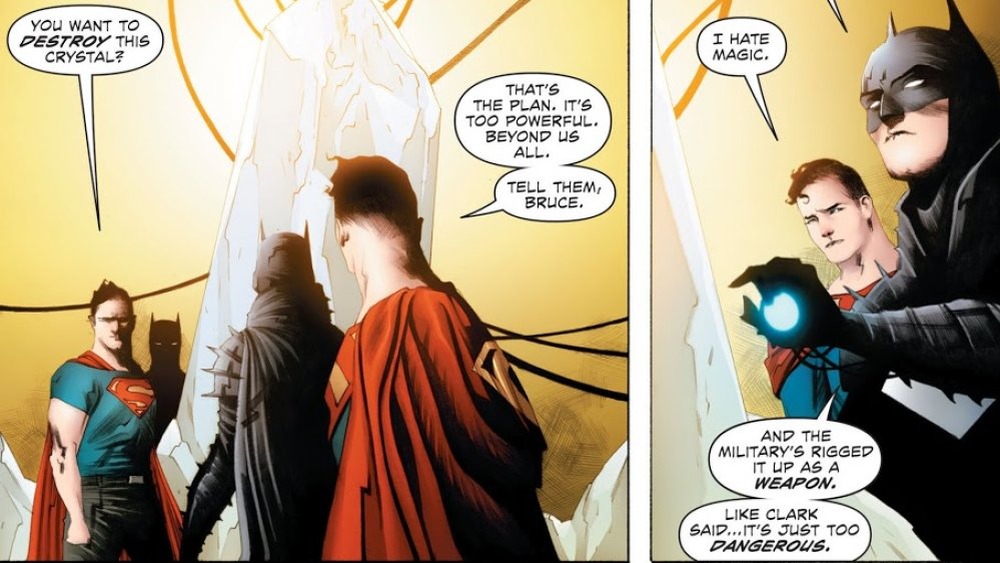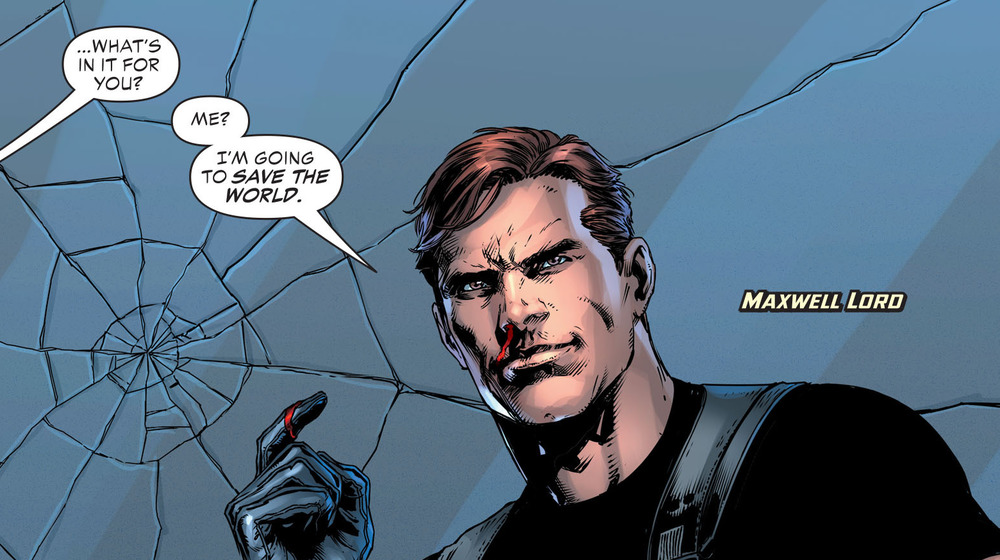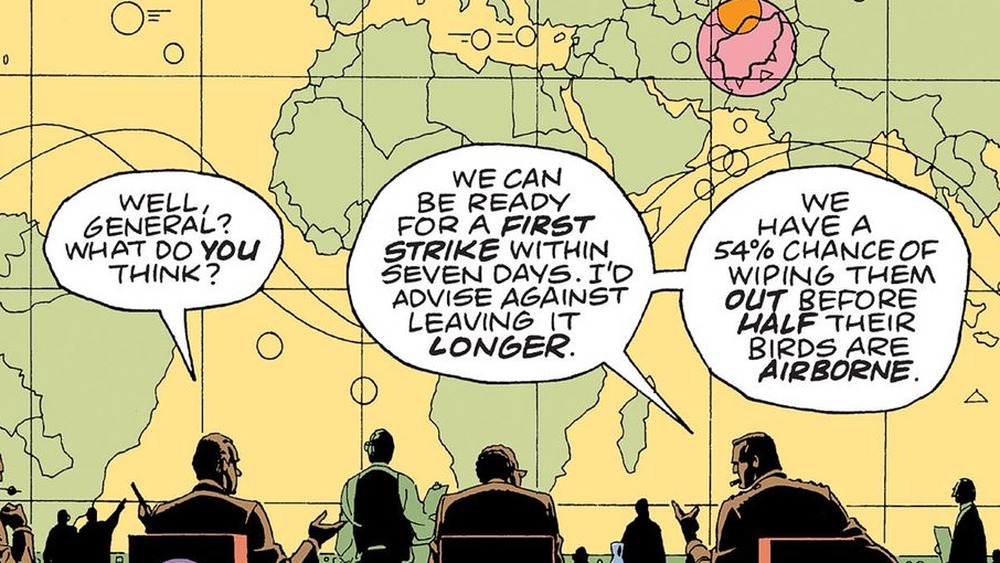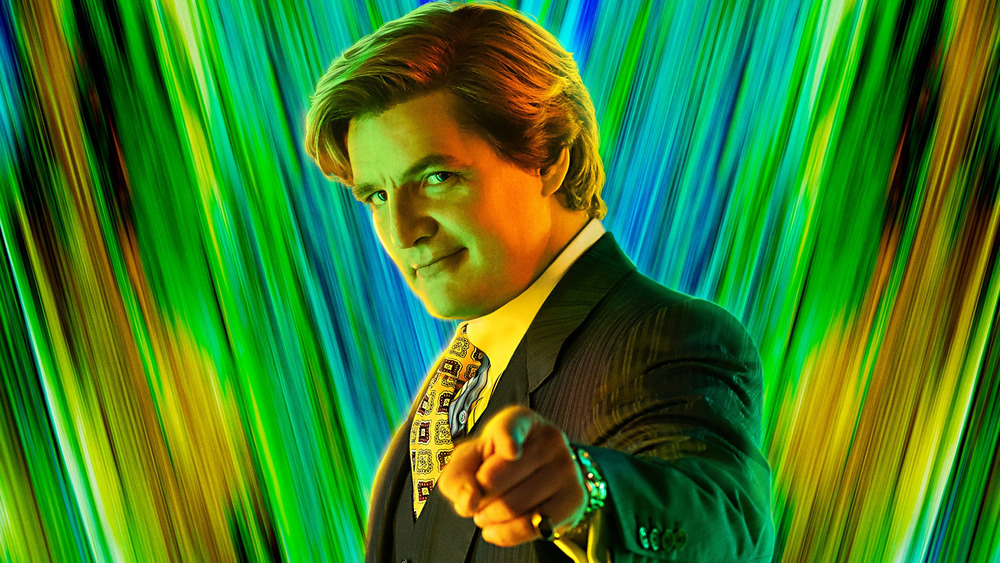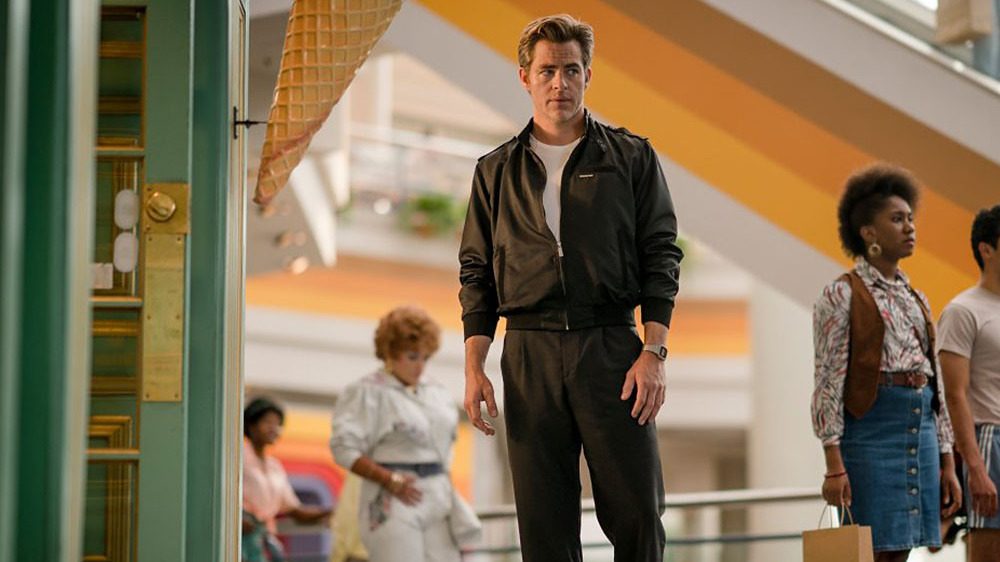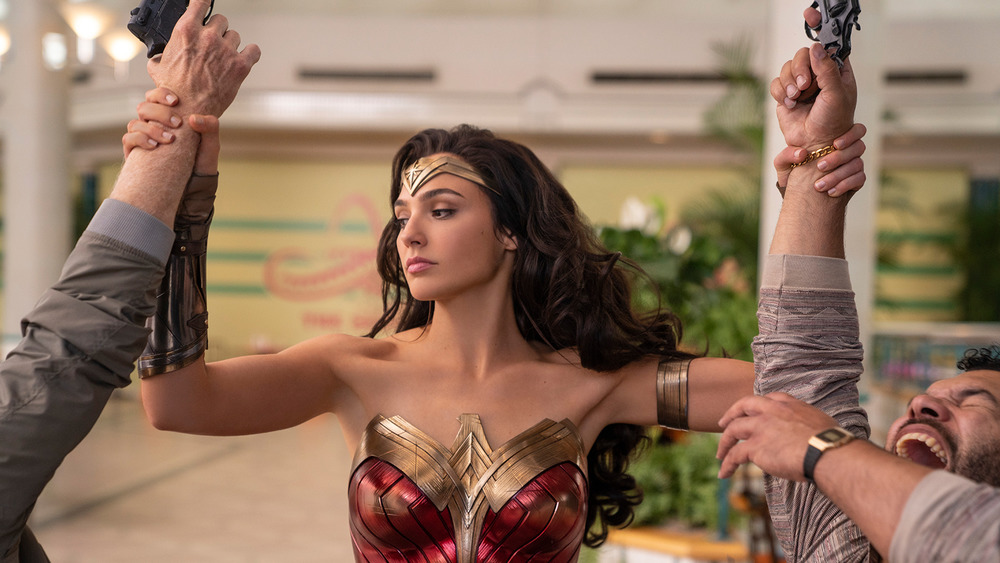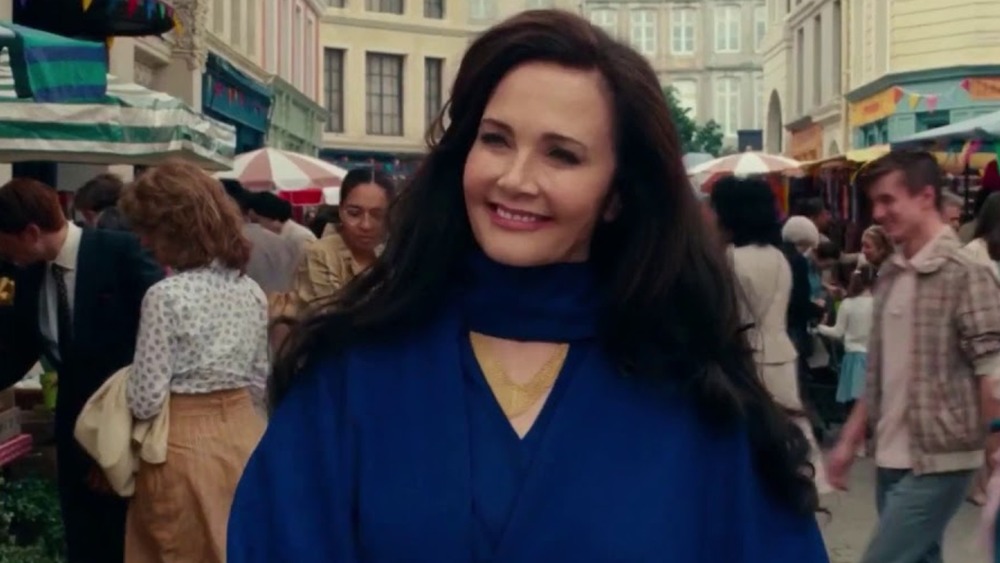Small Details You Missed In Wonder Woman 1984
While Wonder Woman mostly takes place during the events of World War I, Wonder Woman 1984 catapults its hero decades into the future. She arrives in the 1980s, when video games were mostly enjoyed in arcades, music was still played on MTV, and spandex was a valid wardrobe choice, even if you weren't a member of the Justice League.
Patty Jenkins wonderfully recreates the United States of the 1980s in this movie. As early as one of the film's first scenes, we're brought to a busy shopping mall filled with people sporting '80s fashion and businesses that used to be commonplace (think Waldenbooks and B. Dalton) but have been defunct for decades. Jenkins uses these and other subtle details to not only make Wonder Woman 1984 more believable, but more thematically resonant as well.
From radical color schemes to feral fashion to callbacks to comic books and ancient myth, here are some of the small details you may have missed in Wonder Woman 1984.
Warning! If you still haven't seen Wonder Woman 1984, many SPOILERS are on their way!
There are rainbows all over Wonder Woman 1984
There are lots of rainbows in Wonder Woman 1984. They first pop up in a Themyscira flashback, in which young Diana (Lilly Aspell) and her older competitors are required to hit targets releasing colored smoke, to signal how far they've progressed. More rainbows pour in as we switch to 1984 and are dazzled by multicolored flashes from Maxwell Lord's (Pedro Pascal) television ads. Sharp-eyed viewers will also notice that the jogger (Tracy Tobin) threatened by reckless drivers is wearing a rainbow top.
The rainbows continue to appear throughout the film's runtime: Note that Max's son Alistair (Lucian Perez) is wearing a rainbow-striped shirt when he's reunited with his father toward the end of the film. Perhaps most obviously, there is the fireworks display Steve and Diana fly through, which creates a kaleidoscope of rainbows. Even the dangerous Dreamstone continues the theme. Barbara notes it's made of citrine, which can contain rainbow-like sparkles.
You could just take this imagery as a nod to the neon-bright styles of the '80s, but it's likely there's a deeper meaning intended. Remember, Wonder Woman 1984's release date was changed because of the COVID-19 pandemic. At one point, the sequel was meant to be released in June 2020, which would have seen it debut during LGBTQ Pride Month. Director Patty Jenkins made a point of not only revealing the release date on Twitter, but of unveiling a rainbow-themed promotional poster along with it.
Etta Candy returns briefly in Wonder Woman 1984
Wonder Woman 1984 doesn't spend much time going over the fates of Diana's friends and allies from the previous movie. But an early scene introducing Diana's apartment and the photos and other memorabilia she keeps there makes it clear she hasn't forgotten these people. In particular, we see a photo of Diana with an elderly woman who can only be Etta Candy.
Lucy Davis plays the funny and fierce Etta Candy in 2017's Wonder Woman. As Steve Trevor's secretary, Etta takes an instant liking to Diana and helps her blend in with the people of 1918 London. She's not one of the more action-oriented characters of the film, though she assures Diana she's "not opposed to engaging in a bit of fisticuffs, should the occasion arise." Etta was also kind enough to educate the public about the history of the Amazons during the lead-up to Wonder Woman, predicting the story could make a "tantalizing serial."
The picture reveals Diana and Etta remained good friends for many years after the war. Etta's fate isn't specifically mentioned in Wonder Woman 1984, though considering she would be roughly in her 90s by the events of the film, there's a good chance she's passed on.
A Metamorpho villain gets on Maxwell Lord's bad side
One of the first victims of Maxwell Lord's hunt for fortune is Black Gold Cooperative investor Simon Stagg (Oliver Cotton). The first time we see Max visit his offices, the place is practically empty — Stagg is one of the only people there. He tells Max he's discovered the con man is lying about his assets, and warns him he's going to report him to the authorities. It may seem regrettable that Max's Dreamstone powers stop Stagg from putting Lord behind bars, but if this Simon Stagg is anything like the one from the source material, odds are he deserves everything Max does to him and more.
In the comics, Simon Stagg is the CEO of his own company. It's the offices of Stagg Industries International that Max visits, just before getting Stagg arrested in the film. Stagg is most often associated with the strange, transformation-centric hero Rex Mason, AKA Metamorpho. Rex is in love with Simon's daughter, Sapphire, and Simon's attempt to arrange Rex's murder is what transforms Rex into the heroic Metamorpho.
While Simon Stagg isn't exactly an A-list DC villain, Wonder Woman 1984 isn't actually his first screen adaptation. Stagg has shown up in several DC-based animated television series, including Justice League and Young Justice. His only other live-action appearance comes courtesy of William Sadler in the first season of the CW's The Flash.
Steve Trevor has his own ranch
The first time we see the inside of Diana's apartment, it's clear the connections she made during World War I remain important to her. We see a number of photos of friends and soldiers she met in Wonder Woman on display, as well as keepsakes and pictures of her fallen love, Steve Trevor. One of her more prominent photographs actually implies that Diana either spent a good deal of money paying tribute to Trevor, or visited his childhood home after arriving in the States.
The photograph accompanying Steve's watch shows Diana alone, standing under a sign. It's tough to make out the words, but if you squint, you'll see the sign reads "Trevor Ranch." We don't get a story to accompany the photo, but it seems likely that either the ranch Diana visits belongs to Steve's family, or that she established it herself at some point after World War I to honor him.
Either way, a photo of this ranch is a remarkably clever tribute if you think about it. Unlike some of her other photos, there's nothing in the picture revealing Diana was alive during the events of World War I, thus potentially revealing Diana is far more than an average anthropologist. Though curious visitors might wonder why she has a picture of herself taken at a ranch without any horses in frame, they won't look at it and assume she's an immortal Amazon princess.
Wonder Woman 1984 has lots of leopard print
The ruthless Cheetah is one of Wonder Woman's oldest adversaries, and Kristen Wiig's portrayal does her major justice. For most of the film, Barbara Minerva keeps her human looks, though she changes from the mousy scientist we meet in the beginning of the movie into an intimidating powerhouse. It isn't until her final clash with Diana that we see her in her full feline glory, complete with fur and claws.
There are plenty of visual cues throughout the film that set us up for her metamorphosis. When Barbara meets Diana, one of the first things she notices are the hero's leopard print heels. This is fitting, since it's Diana who Barbara wants to be when she makes her fateful Dreamstone wish. Moreover, the first embarrassing outfit Steve Trevor tries on for Diana includes a leopard print top, and the couch in Maxwell Lord's lavish office includes leopard print accessories. Alongside all this feline fashion, there is also a taxidermized wildcat often seen behind Barbara when she's at the Smithsonian.
Cat imagery isn't the only visual cue used to illuminate Barbara's story. When she begins to discover her newfound super strength and goes to a gym to gauge exactly how strong she is, she's dressed in a blue outfit. It's probably not a mistake that this is the same color used to represent young Diana during the Themysciran games.
The Dreamstone is more than just the Dreamstone
Plenty of DC Comics fans will likely recognize the name of the Dreamstone as soon as they hear it. In the comics, this stone is most closely associated with the villain Doctor Destiny and the godlike Dream of Neil Gaiman's seminal Sandman comics. But considering both its physical appearance and its abilities, Wonder Woman 1984's Dreamstone takes inspiration from both its comic book namesake and another DC Comics artifact.
Back in February 2020, Entertainment Weekly posted a series of photos from Wonder Woman 1984, including one that showed Maxwell Lord pointing at the Dreamstone on Barbara Minerva's desk. Many comics fans identified the mysterious object as the Chaos Crystal, or one of its powerful shards. This crystal first appears in 2013's Batman/Superman #3. Like the film's Dreamstone, the Chaos Crystal has wish-granting abilities. It's also said that the Chaos Crystal comes from the Sphere of the Gods, a reality where many of the DC universe's deities exist. Indeed, when Diana first examines the Dreamstone in the film, she's shocked to discover writing in the language of the gods.
Notably, the Dreamstone of the source material grants the ability to reshape reality and pull images from dreams, but doesn't actually require a specific wish. So while the artifact in question is called the Dreamstone in the film, its abilities are arguably closer to that of the Chaos Crystal. Though, we have to admit, Dreamstone does sound cooler.
Maxwell Lord's White House nosebleed
On the surface, Pedro Pascal's Maxwell Lord is significantly different from the Lord of the comics. His origin story, powers, and the abilities he eventually gains from the Dreamstone aren't at all similar to those of his comic book counterpart. But the makers of Wonder Woman 1984 pay visual tribute to the source material in a very specific way comic fans will notice.
When Max goes to the Oval Office, granting the U.S. president's wish turns out to be more of a physical strain for Lord than any of the wish-granting we've seen him pull off previously. Before Max can finish creating all the new missile sites for the president and everything that goes along with it, we see a single stream of blood trickle from Max's nostril to his lips.
This isn't a particularly unique visual, nor is it surprising, considering the epic scope of what Max is creating. But in this case, it's a clear tribute to his comic book roots. When Max is introduced in 1987's Justice League #1, he doesn't have any superhuman abilities. But after the events of the 1988 DC Comics line-wide event "Invasion!" and its accompanying miniseries, the detonation of a so-called "gene bomb" gives Max the ability to mentally control other people's actions. Using this power always gives Max a nosebleed, just like the one he gets in the White House.
Wonder Woman 1984 feels like a cousin to game-changing graphic novels
For the most part, Wonder Woman 1984 is a relatively fun and optimistic movie. You probably won't find many critics comparing the film to some of the darkest comics of the '80s. But if you're familiar with the work of Alan Moore and Frank Miller, it's impossible not to think of their game-changing masterworks, Watchmen and Batman: The Dark Knight Returns, while watching Diana Prince's latest adventures.
Watchmen and DKR are often compared to one another for a whole lot of good reasons. One particular plot point they share is the threat of an impending nuclear war between the United States and the Soviet Union. In both cases, that threat is complicated by the presence of super-powered beings. In Watchmen, we eventually learn that Ozymandias sets his fiendish plan in motion to stop World War III from razing the globe. In DKR, Superman is the United States' most powerful weapon in their conflict with the USSR, and the Man of Steel almost dies stopping a Soviet nuke from killing Americans.
As a result, it's nearly impossible for comics fans not to recall those seminal stories when the US president's wish for more nukes almost causes the Cold War to turn hot. The comparison grows more obvious when American citizens run wild in the streets, just as they do in both Watchmen and DKR.
Maxwell Lord is the anti-Olympian
When we first meet Maxwell Lord, he's introduced as the famous CEO of the Black Gold Cooperative. Sharp-eyed viewers will notice that his company's logo is a warning for what the villain has in store for the world. It bears two columns of half circles, like rings snapped in half, facing away from each other. What, if anything, does that signify?
For the answer, we need to look at the beginning of the film. Wonder Woman 1984 opens with the Themysciran Olympics. In the comics, Diana must triumph in a similar competition for the right to leave Themyscira and accompany Steve Trevor to "Man's World." In the real world, what image is most closely associated with the Olympics? The multicolored Olympic rings, of course, which are connected to represent the nations of the world united in peaceful competition.
If an image of linked rings is meant to symbolize a united world, then what does the logo for Max's company represent? Its severed rings warn us of what Max's Dreamstone creates by the end of Wonder Woman 1984: A disconnected and divided world erupting in chaos and violence.
Steve Trevor isn't very good at predicting the future
One of the funnier aspects of Wonder Woman 1984 is watching Steve Trevor deal with how things have changed since 1918. He confuses a wastebasket with modern art, initially thinks breakdancing is a menacing new form of combat, and, perhaps most tragically, seems to think fanny packs are pretty cool.
While Diana seems just as amused as the rest of us by these antics, there's at least one joke even she doesn't get. When Steve brings Diana to the apartment of the engineer whose body he's borrowing, she asks him how he found her. He tells her that he found her name in the phone book. He muses, "I guess some things are just future proof." Of course, as we know now, if Steve had been resurrected in 2020, he'd not only have a tough time finding Diana in a phone book, he might not even be able to find a phone book at all. Though ironically, with social media, Steve could probably find her even quicker — assuming he could figure out how to work a computer.
Steve's line is especially funny given the fact that this movie was released in 2020, a year that even time travelers from 2018 would find bizarre, let alone those from 1918. The writers who penned this dialogue themselves couldn't have anticipated how darkly ironic it would become.
Wonder Woman 1984 includes some family cameos
In mid-December 2020, Gal Gadot revealed she wouldn't be the only member of her family appearing in Wonder Woman 1984. The actress disclosed that both of her daughters and her husband Yaron Varsano would make cameos in the sequel. Not long after, director Patty Jenkins said her son would also appear in the flick.
We can't point you towards every one of these cameos — Jenkins said her son appears in the film three different times — but we know of at least one appearance. It's perhaps the briefest "attack" on Diana Prince in the film. After Max renounces his wish and his plans are thwarted, Diana is accidentally pelted with a snowball as a young boy and girl play nearby. They apologize as she walks away, though obviously, Diana feels more amused than anything else. The boy is Patty Jenkins' son, Asa, and his snowball rival is Gadot's older daughter, Alma.
Funnily enough, Gadot was pregnant with her youngest daughter Maya while filming 2017's Wonder Woman. So in a way, Maya had already made a cameo — though obviously without any wardrobe or dialogue.
Asteria is a Wonder Woman all her own
Wonder Woman 1984 wouldn't really be a superhero movie if there weren't a post- or mid-credits scene, would it? Patty Jenkins makes good on this with a fun mid-credits scene revealing the fate of Asteria, the ancient Amazon hero who originally wore the golden-winged armor and held off hordes of men so her sisters could be free. In the scene, a dark-haired woman in blue effortlessly stops a falling wooden post with a single hand, saving a young girl. When the girl's mother stops the mystery woman to thank her, we learn that not only is she the legendary hero Asteria, but that she's played by none other than Lynda Carter.
If you're too young to recognize Carter or just not up on your superhero media, the actress is best known for playing Wonder Woman in the beloved 1975 Wonder Woman television series. Including her as something of a predecessor to Gal Gadot's Diana in the DCEU is a wonderfully fitting stroke of brilliance.
This isn't the only time Carter's been called back to the superhero world either. The actress played the principal in 2005's Sky High, made a one-off appearance on Smallville, and landed the recurring role of President Olivia Marsdin on the CW's Supergirl, who is forced to resign from office when it's discovered she's from outer space.
